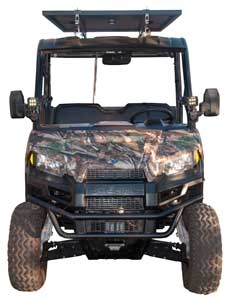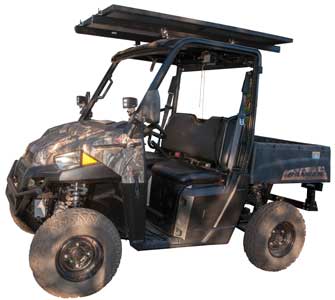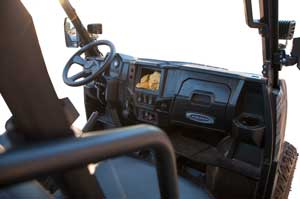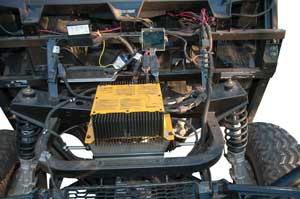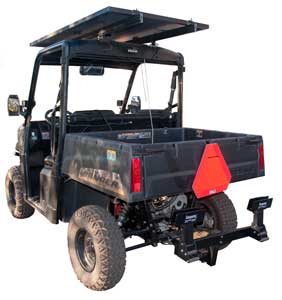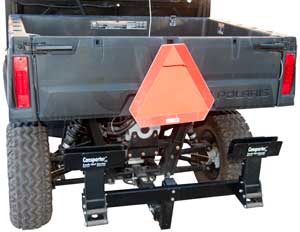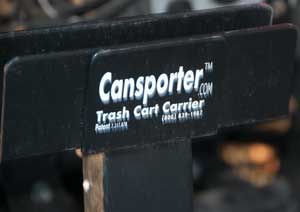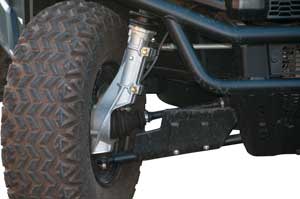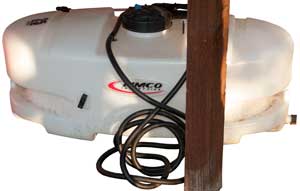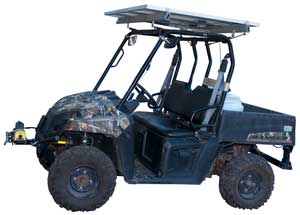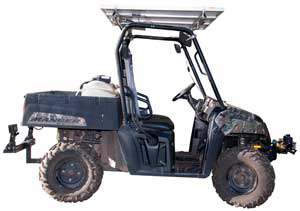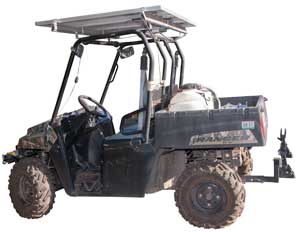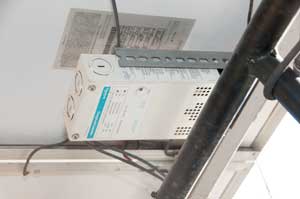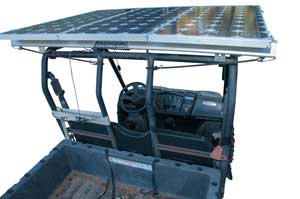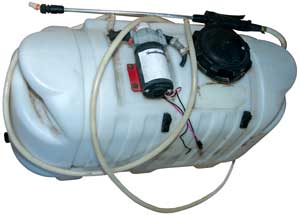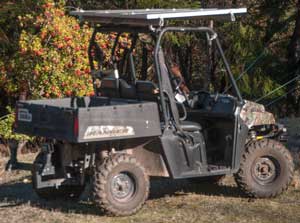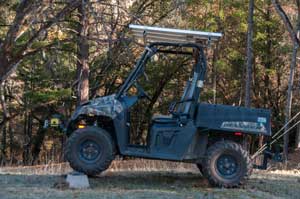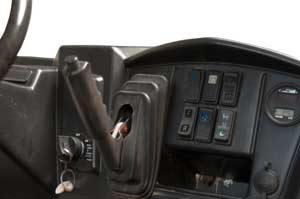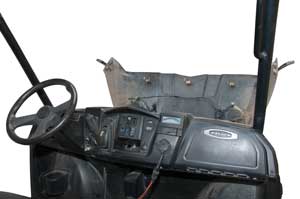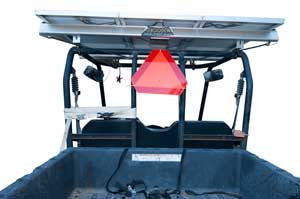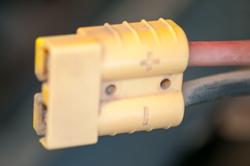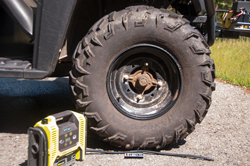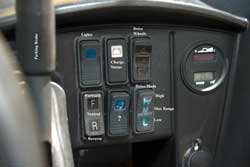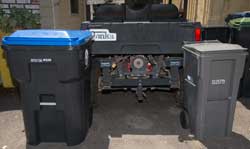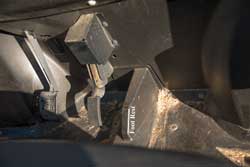ATV Fire Truck - Polaris Ranger EV
© Brooke Clarke 2020 - 2024 |
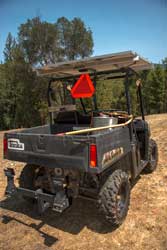 |
Description
Notes on Operation
Polaris Ranger Lineup
48 Volt Battery
Charger
Inverter
Motor
Torque at Zero RPM
Motor Electronic Speed Controller
Transmission
Solar Panel
Charge Controller
Ranger EV Bed
Winch
Battery State of Charge
Photos of Friends Ranger EV
Photos of my Ranger EV
Fire Related
Fire Water Pump
Hoses
Indian Back Pack Pump
Weed Sprayer
Hand Tools
Miscellaneous
Patents
YouTube
Front Loader
Related
References
Links
Background
There may be a need to fight spot fires started by hot embers (firebrands) before there's an evacuation order or after the fire has passed (access?). Being a senior citizen with a bad back there's no way to carry heavy equipment to wrangle water fire hose.
A possible answer is to use a 4-wheel drive quad, like the Polaris Ranger EV. I have it on good authority that this particular vehicle it the most versatile in the hills. Models that use a centrifugal clutch, like on early go carts, are poor at climbing hills.
But what to carry since there's a weight limit?
At my house I've got a hydrant with plenty of pressure and flow, so for here don't need pump or tank if hose can be laid. A more expensive option would be to plumb property with 1-1/2" NH hose bibs so a 100' hose would get to the Ranger EV no matter where it was. A simpler and lower cost option would be to carry about 4 each 100' hoses which could be laid from either my hose bib (limited by the water meter to 15 GPM @ 100 PSI) or to the hydrant (very high GPM @ 100 PSI).
There are neighboring houses at higher elevations where the water pressure is more like 20 to 30 PSI so working from thier hydrents would require a booster pump. I used the word "booster" since the output pressure is the sum on the input pressure, say 20 PSI, and the pump differential pressure at a given flow rate, say 60 PSI, which would get you to 80 PSI.
The 500 pound weight limit for the Ranger EV bed translates to (500# / 8.3#/Gal) 60 Gallons max. But will be less because of weight of pump, hose, nozzle, tank &Etc.
I've watched a number of YouTube training videos on Wildland fire hose packs and hose lay technique. The all have some common features:
1. The path where the hose will go is thoroughly whetted before the hose is on the ground. Probably to prevent the hose catching fire.
2. An empty hose weighs a lot less than the same hose filled with water. So one man can pull an empty hose, but it may take two men to pull a hose full of water. The size makes a big difference here. 1" NPSH hose can be pulled by one man when full of water and is a standard for fighting wildland fires.
Fire Hose Filled with Water
100' Hose
Area
Sq in
Vol
100'
Cu in
H20
Vol * 0.036
#
Hose
+ H20
#
3/4" Garden
0.4417
530
19
38
1"
0.785
942
34
40
1-1/2"
1.77
2121
76
106
2-1/2"
4.9
5890
212
275
If the coefficient of friction with the ground is 1 then the force needed to pull a full hose would be the same as it's weight. The table above is for a single 100' hose.
In a real world situation there may be 5 or more hoses connected in series, so the total weight gets way to heavy for all the hose to be pulled. That's why hose is laid 100' at a time then filled with water. By inserting a Wye every now and then a tap provides for another hose to be added. Also a Gated "Y" adds a valve to a plain Nozzle. So by adding a plain Nozzle on the "Y" but not another hose you have a valved nozzle.
Normal fire engines are designed to fight structure fires where a lot of water (2-1/2" hose is the most common) is needed.
Wildland fires may involve large trees on fire, but the purpose of this vehicle is to put out smaller fires which if left on their own would light larger fuel sources.
This seems to be pointing to the use of either 1" or 3/4" garden hose. The 1" canvas type wildland fire type hose is much lighter and takes up much less space than the solid wall garden hose so may be the best choice.
Another option might be to tow a trailer fire skid, like the Multiquip WT5HP. There are many problems with that:
1. A Class 2 hitch is rated for 3, 500 pounds max (UHaul) and the trailer (1428 #) plus 4,381# of water (525 Gal2Pounds) = 5,809 pounds total.
2. The Ranger EV is rated for 1,500 lb Towing Capacity (Polaris).
1500 # is a lot more than the 1,000# load capacity of the Ranger EV, but after subtracting the trailer weight the gain may not be worth the disadvantage of a trailer v. the vehicle by itself.
Maybe removing the tilt bed and replacing it with a made to order fire skid would have more capacity?
Description
Notes on Operation
2020 December 6 - on a short drive around my property it was discovered that the tires were very under inflated. Also discovered that some tree branches are low enough for the solar panel to get brushed. Those will need to be trimmed. Note I was thinking of changing the solar panel to allow tipping it up to face the sun, but that would make for a real problem hitting low branches. Instead need to look into ramps to tip the whole Ranger for better solar panel to Sun angles.
2021 July 1- It turns out a couple of weeks after I wrote the above paragraph there is enough sun to keep the battery fully charged even though I'm driving it a couple of times a week to move the garbage and recycle bins.
7 Dec: The left rear tire was very low (probably the one wheel that's driven) but the other tires were also at about 10 PSI. Markings say 32 PSI max, so I inflated to about 24 PSI.
When driving on a rough trail or when there may be a change in pitch controlling the throttle may be difficult or impossible if you use it like in a car. But . . . there is a foot rest provided that allows your right foot to be on the foot rest AND on the throttle. That way you can control the throttle while there's movement of the ATV. See Fig 134.
There are a half dozen switches on the instrument panel, see Fig 131. They are:
Lights
Charge Status
blinks while AC line Charging
No. of Drive Wheels
1: used almost always
2: both rear wheels - no differential, so harder to steer
4: all wheels - near impossible to steer
Forward
Neutral
Reverse
Fan?
Let me know what this does
and when to use it.
Drive Mode
H: High Speed - with regenerative braking
M: Max range - no regenerative braking
L: Slow Speed - with regenerative braking (almost all of the time)
Polaris Ranger Lineup
Motorsports of Ukiah - the source of the Polaris Ranger EVs
Model
Disp
cc
HP
Payload
lbs
Box
lbs
Hitch
lbs
500
500
32
1000
500
1500
EV
na
35
1000
500
1500
570
567
44
1000
500
1500
1000
999
61
2070
1000
2500
1000 XP
999
82
1920
1000
2500
48 V Battery
The stock Ranger EV uses 8 each 6 V lead acid batteries for a 48 VDC system. These batteries add many hundreds of pounds to the vehicle weight.
This may be why the gasoline version of the Ranger can carry about 1,000 pounds in the bed compared to the 500 pounds for the EV version. Note the batteries are located below the seats as close to the ground as possible so add a lot to stability and low center of gravity which in turns translates to better hill climbing (See 3-wheel electric trike)
Group/series 27 batteries contain 214 Amp hours of charge (Powerstride), weigh 58 pounds each (pack 464 lbs). - This is consistent with the decrease of 500 lbs in the box capacity v. gas engine version.
The Powersonic PS-6000 (an equivalent battery) is rated 180 AH @ 36 Amps (5 hour rate) load, or 134 AH @ 134 Amps (1 hour rate) load.
Trojan L16H-AC battery has more capacity (saw it mentioned as an upgrade). They sell for about $550 each ( $4,400 for a pack). I think these are used in solar powered homes.
If Lithium batteries replaced the lead acid batteries, the weight limits should be substantially increased, but at what additional cost?
YouTube: Linear Technology: Lead Acid Battery Balancer, LTC3305 - eBay lists the "Battery Equalizer HA02 Used For 48V Lead-acid Battery Balancer Charger Battery" for about $45. It would take two of them for the Ranger EV since it has 8 batteries.
Allied has LiFePO4 chemistry 48 Volt batteries that are about the same size as the 6 V lead acid batteries. This way you connect either 6 or 8 of the 48 V batteries in parallel. Their kit includes a State Of Charge meter and charger. By having each battery at 48 V no balancing is needed like when batteries are connected in series (the stock battery is series connected).
Maintenance
Periodically (every ?? hours or?? months) the batteries should be topped up with Distilled Water (Wiki). To make this easy my Ranger EV is fitted with the optional battery watering system. There's two filler tubes, one on each side, and a squeeze bulb pump. Push the Yellow button to clip/unclip the pump. See Fig 25 below. Note with the gallon water jugs sitting on the seat, above the batteries, you only need to use the hand pump a few times to get most of the air out of the tubing and after than siphon action (Wiki) will move the water to the batteries. tubing.
Battery Design
2024 March: This golf cart web page [2024] The Ultimate Guide Of Golf Cart Battery by Li Time batteries says 120 Amps draw at 48 Volts is reasonable for a stock cart.
48V * 120A = 5760 Watts or 7.7 HP. This seems more reasonable than my earlier estimate that the HP would be about the same as the lowest gas powered Polaris Ranger model, i.e. about 30 HP. PS learned about the Trail Tech Striker combined instrument for: Speed, Voltage and Temperature.
The golf cart web pages talk about different battery configurations:
The Max current depends on the battery, so series strings using the same battery will have the same max current.
Batt
Voltage
No. of
Batteries
Pack
Voltage
Max
Current
12
3
36
low
12
4
48
low
8
6
48
med
6
8
48
high
For example the Trojan T-105 6V battery is specified to deliver 75A for 115 minutes (143Ahr), but can only deliver 250A for 20 minutes (83Ahr).
At 11.25A the battery will last 20 hours, i.e. 225Ahr which is the common rating.
Charger, Built-in
Delta-Q Technologies: QuiQ 1000W - YouTube:
Selecting a charge profile on the Delta-Q QuiQ Charger -
I bought this unit around Winter Solstice and so plugged it into the house 120 VAC to keep the battery charged. Only did that a couple of times. Since they the battery is always fully charged just from sitting in the Sun.
Inverter By adding a 48 Volt input inverter the batteries in the Ranger EV can be used for applications where a generator would otherwise be needed.
Sensata Technologies SM4448PAE 4,400 Watt Pure Sine Inverter - 120/240 VAC 60 Hz single phase output Also see my Generator page UPS section.
This is twice the power of the Honda 2200 Watt generator (Generators) and about half the power of the Honda EU7000iS generator. But it's a self powered generator in the sense you can drive it to where you need the power.
Motor
1HP is 746 Watts. So 35 HP = 26110 Watts. Current at 48 V is 26110/48 = 543 Amps. Something looks wrong! (See Battery Design above) Maybe the Electronic Speed Controller (Wiki: ESC) outputs a higher voltage and so less current is needed?
Chapman Electric Co. - parts & repair of fork lift motors. Ranger Forums: Ranger EV Motor Rebuild -
Silver Wolf Motors makes a conversion kit for Golf Carts that replaces their DC or AC induction motor with a BLDC motor. It offers more range (higher efficiency), less motor weight and works on 48 to 72 VDC systems. I found them from their YouTube channel where they were promoting their 4WD kit to upgrade 2WD Golf Carts to 4WD.
Club Car (known for Golf Carts) also makes an UTV similar to the Polaris Ranger EV.
Their 500 model has a 48 VDC system & 20 HP motor. Maybe the Polaris EV motor is closer to 20 HP?
Golf Cart (Wiki) electric motors tent to be either 36V or 48V, so I suspect this is a 48V golf cart motor.
2429153 Centrifugal clutch, Charles D Ammon, Raymond M Snyder, Fitchie Guy, 1947-10-14, -
2556512 Variable ratio drive mechanism, Charles D Ammon, Cushman Motor Works, 1951-06-12, - uses a V-belt (Wiki) & variable diameter pulley. The motor pulley had an automatic centrifugal clutch so at idle you did not need to engage a clutch - Cushman (Wiki) made a number of vehicles that used this v-belt pulley system.
2869919 Utility bodies for vehicles and tail gates therefor, Cushman Motor Works, 1959-01-20, - 3-wheel golf cart
Torque at Zero RPM
One of the GREAT features of DC motors is that the torque depends only on the current. See the video on stall torque on my Testing DC Motors web page.
This is very different than gas or diesel engines where the torque varies with the RPM and for these there's zero torque at zero RPM. So, when starting from a stop going up hill with a gas or diesel vehicle you need to do some fancy brake, clutch and gas pedal work. This would be easy if you have three legs, but for those of us with only two feet it requires some dexterity. With the DC motor there is no clutch, so it's very easy because you can develop any torque the motor can deliver at zero RPM.
The problem with the Ranger EV is that you can not use the gas and parking brake at the same time. This prevents you from driving off with the parking brake on.
So if stopped on a hill you need to apply the foot brake and then use the gas pedal to overcome the foot brake.
Motor Electronic Speed Controller
Probably Borg Warner Gen4 Size 2/4/6 - sales brochure - Renault City Car (Sevcon 48V Gen4 motor controller) - "Regenerative braking allowing reduced battery power consumption"
Battery Power Gauge - Smartview LCD Display : Battery state of charge (10 bars) & run time in house (probably the Polaris gauge), (CAN 2.0B passive up to 500k).(Wiki: CAN bus)
Note the Ranger EV has three Drive Modes (Owner's manual pg 10 Features and Controls):
Switch
Name
Range
Torque
Top Speed
MPH
Regenerative
BrakingProblem
L
Low
Lowest
100%
10
Max
Increased battery usage
M
Max Range
Highest
50% 15
None1
H
High
Intermediate
70%
25
Min
Increased battery usage Note 1: The owner's manual says "Min", but if you test it there is none in "M" range. i.e. to get maximum range there's no regenerativebraking.
L (Low, has maximum torque and regenerative braking. lowest range), M (Max Range [not medium] has NO regenerative braking), H (High, has light torque regenerative braking, medium range)
Transmission
The All Wheel Drive (AWD) switch has three positions:
Position
Function
Meaning
Problems
Recommended for
4WD
All wheel drive
Front wheels drive if rear wheels slipping
wheel scrub & hard steering
very difficult situations only
2WD
Rear Wheel drive
Differential lock
wheel scrub when cornering
only if drive wheel spins
1WD
One rear wheel drive
Use most of the time
Minimum traction & tire wear
everyday use
Solar Panel
The solar panel will charge the battery, not just keep it from going flat as a lead acid will do if left by itself. The solar panel is way too small to power the vehicle, but if use is infrequent, like driving a couple of miles to get the mail on a daily basis, then the solar panel probably will be enough. The rate of charge can be greatly improved by aiming the panel at the sun. That might be done just be parking the Ranger EV on a slope or by the hardware that attaches it to the Ranger.
My friend has a single 200 W panel.
My unit has three Siemens 75W panels.
He lives on a hill top so can park with a great south exposure so gets charging sun all day.
I live in a forest/jungle and so need to find a spot where I will get some sun. As I write this it's a little over a week from winter solstice so the sun is low in the sky. Need to find a way to get more solar power into the batteries.
Vo=22V (Vo max: 66V), Is=4.8A
Rated 17V @ 4.4A = 74.8W per panel.
"These (SP75) solar panels are factory configured for 12V operation but may be field configured for 6V." Now to learn how. At 6V they would be a good match to the GVB-8 charge controller.
2020 Dec 16 - It turns out that the SP75 panels can NOT be changed to 6 Volts in the field.
BUT . . the three "12 Volt" panels can be connected in parallel and power the GVB-8 that way. This works because the current out of a solar panel is proportional to the light falling on it. So each panel will supply current to the charge controller.
Radiant Solar Technology, Inc. - the source of the solar panels.
Charge Controller
My friend's Ranger has the Genasun GVB-8-WP (Boost) MPPT unit rated for 8 Amps.
Asking Sun Forge LLC about this controller and the Solaria PowerXT-400R-PM panel:
https://static1.squarespace.com/static/568f7df70e4c112f75e6c82b/t/5f627a9f26c3bc36e2bc736a/1600289442777/Datasheet_PowerXT_Resi-400PM.pdf
"The two input parameters for that charge controller are:
1) The PV input Voltage at maximum power (Vmp) needs to be under 43.0V
2) The PV input Current at maximum power (Imp) needs to be under 9.0A.
As you mentioned, the STC rated Vmp on the Solaria PowerXT®-400R-PM panel (42.4V) is within specs, thought the STC rated Imp (9.4A) is slightly over.
Although I cannot directly espouse any configuration which exceeds our recommendations, given your latitude and the fact that the panel's NOCT rated Imp is 7.5A, you will likely not have any issues, especially when flat mounted."
Note the Vmp (42.4V) and Imp (9.4A) are at 1000W/sq m. At 800W/sq m they are 40.0V and 7.59A. I've learned that the solar flux around me is near 800 W/sq m most of the time or less.
My Ranger has the Schneider Electric - C40 PWM charge controller rated for 40 Amps (60A ?) panel current.
Xantrex - C40 PWM Controller - The CM/R is a remote meter that can display: Array/Load Current, Battery Voltage, Resettable Amp hours, Total Amp hours.
The front panel also has a decoeder for the LED. Count the number of blinks in a group.
1 Green: (probably not charging) >3V below the bulk V
2 Green: charging and between 1.5 & 3V below bulk V
3 Green: charging and between 1 & 2V below bulk V
4 Green: charging and between 0.5 & 1V below bulk V
5 Green: at bulk voltage
Solid Green: Floating
MPPT v. PWM Charge Controllers
Pulse Width Modulation
These drop the panel voltage by turning on and off the panel so that the percent of on time is the desired output voltage as a percent of the panel voltage. It's a way to drop the voltage to whatever is desired for the battery, BUT the current is the same as supplied by the panel. In this case assume a sunny summer day. Each panel can deliver 4.4 A at 17 V so the array of three panels delivers 51 Volts at 4.4 Amps, but the battery needs 41 Volts so the battery gets 41 V @ 4.4 A or 180 Watts.
Maximum Power Point Tracking
The operating point is moved to maximize the power from the panel and the voltage is dropped and the current to the battery increased so in the example above:
3 * 17 V @ 4.4 A = 224.4 W. Battery voltage 41, current = 224.4W/41 = 5.5 Amps.
So the full 225 Watts is delivered to the battery instead of 180 Watts, 125% more power.
There is also a battery temperature sensor (BTS).
Best guess at internal settings: Charge Control, 48V battery, Manual Equalization, Bulk charge V? (between 52 & 60, default 59.2), Float charge V? (between 50 & 58, default 54.0), Low V reconnect (between 48 & 56, default 55.2), Low V disconnect (between 42 & 50, default 46.0).
In 48V battery configuration, panel Vmax: 125 V, Panel Imax: 40 Amps.
2024 May
YouTube: Renogy Rover Boost + CIGS Flexible Solar Panel = Solar Golf Cart, 6:32 -
Renogy 1 (909) 287 7111 - 36V/48V Rover Boost 10A MPPT Solar Charge Controller -
Ranger EV Bed
It might make sense to remove the tilt bed and it's tilt mechanism to save weight. Maybe a purpose built frame to hold the tank, pump &Etc would weigh less allowing more water or hose?
An add-on might be a place for an EMT Backboard stretcher like used for rescuing people. These are 72.75" x 17.75" x 2.5. A hose tray could be made to fit the same mounting space as the EMT Backboard.
The hose tray could be pre-loaded with a lot of 1" wildland fire hose, some nozzles and related tools and adapters.
Winch
This is a receiver hitch mounted winch, not the factory winch mounted on the front.
Superwinch model: UT3000
40' of 3/16" wire rope with the ability to power load in and out. There's also a manual spool unlock to pull out the cable & Hook.
It's recommended to not attach the hook to the wire rope since that may damage the wire rope.
So a recovery tree strap should be used with a Shackle.
Ordered from eBay: "BBG4x4 Recovery Tow Strap Recovery Kit (Strap 30 ft + Hitch Receiver + Shackle)" for under $100. Includes: 3" x 30' strap, 3/4" D-Ring shackle, 2" receiver with 5/8" shackle & bag.
Will also be ordering some straps, shackles and a split snatch block to be used for the process of felling trees. See Cars\Live Steam\Murray Brothers Yarder - Donkey for ways the Ranger EV can be used for logging.
Battery State of Charge
The Victron Energy Smart 500 Amp shunt looks interesting, but getting a dedicated display costs twice ($250) as much as the smart shunt ($100).
There are no name DC Multifunction Battery Meters with Shunt on eBay for under $20 that include a LCD display. The "Renogy" brand "500A Battery Monitor With Shunt" (manual.pdf) is under $100.
Photos of Friends Ranger EV
Fig 1
Fig 2
Fig 3 Note the US 115 VAC plug appears as if it was not ever used. The solar panel charges the battery. This works because of light use. This plug is not supposed to be used like this. That's to say the hood should be opened when the AC charger is in use to allow cooling air to circulate.
Steering Wheel tilt is adjustable.
Fig 4
Fig 5 Genasun GVB-8-WP (Boost)
This model specifically for this application (or golf cart).
Fig 6 Yellow box is AC line charger.
Fig 7 Built-in 48V Charger
Output: 48V DC 18 Amps (864 Watts)
Battery: 24 Cell (48VDC) 50 to 360 Ah
Charge time depends on battery in range 3 to 20 hours.
Fig 8 Cansporter
Fig 9 There are two upper shock anchor locations.
Fig 10 Cansporter.com -
7217078 Waste receptacle transporter See Fig 6 & 7
Fig 11 MacPherson Strut (Wiki) Front Suspension
Fig 12 Fimco Ind - 25 Gal Spot Sprayer
60 PSI, 2.4 GPM 12 VDC pump
Photos of my 2012 Ranger EV
Fig 0
Fig 1 There are 3 solar panels.
Only one location for upper shock anchor point.
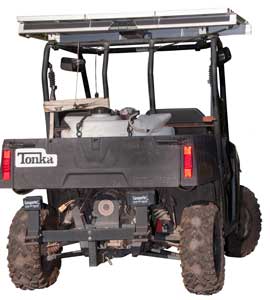
Fig 2
Fig 3
Fig 4 Steering wheel tilt is not adjustable.
Fig 5 There are 3 solar panels.
Fig 6 Moving gray and blue cans
Fig 7
Fig 8 After cleaning solar panels.
Fig 9
Fig 10
Fig 11
Fig 12 Looks like the Fimco Ind - 25 Gal Spot Sprayer
60 PSI, 2.4 GPM 12 VDC pump in Fig 12 above
Fig 13 2020-Dec-10 near Solstice (Wiki) = low sun angle
State of charge at one tick below 100%.
Let's see if it will charge.
Need to make some measurements to see if solar panel is level when road is level.
Fig 14 Siemens 75W, Vo=22V, Is=4.8A
Rated 17V @ 4.4A = 74.8W
Fig 15 It was in the sun an hour ago, but now shade.
In 1-wheel drive pushes blocks, in 4-wheel climbs them.
Since panel wiring is at back the front could be tipped up.
Fig 16 Under the hood. Extension cord connected.
FIg 17 The top center white Battery icon is blinking, even when the key switch is OFF.
Fig 18
Fig 19 Superwinch UT3000
Fig 20 In order to unload a can the lever needs to be
in the locked position as shown here.
Fig 21 Passenger side batteries and motor controller in center.
Fig 22 Added Slow Moving Vehicle Triangle
Fig 23 Fig 24 me and garbage bins
Fig 25 Watering Batteries
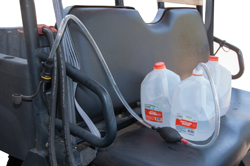
Fig 26 Rear 12V winch connector, 1-5/16" wide
Anderson Power Products SB 50
Fig 27 48V Battery Connector 2-1/8" wide
External Inverter or external charger
Anderson Power Products SB 175
Fig 28 Front Winch 12 V connector
Anderson Power Products SB 50
Fig 129 Rear 12V Winch connector w/o cap
Anderson Power Products SB 50
Fig 130 Inflating Tires (17 PSI)
Riobi air compressor -
also 1 Gal water on each side for batteries
Fig 131 Switches + Mystery switch
Fig 132 Two bar lengths on Waste bins.
Fig 133 With Smith Indian Fedco Fire Pump & McLeod Tool
Fig 134 Foot Rest (works with gas pedal in rough going)
Front Loader
Little Buck Loader makes a loader that connects to a 2" trailer hitch called the Z-Buck. Also fits zero turn mowers.
Trying to learn more about it.
Fire Related
Fire Water Pump
A small reliable pump is the Honda WH15 which weighs 50 pounds. 98 GPM max, 57 PSI max, 1.5" NPT input and output. (but is far inferior to the WH20).
The Honda WH20 water pump weighs 52 pounds. 132 GPM max, 61 PSI max, 2" NPT input and output. Has an excellent reputation.
500 # bed weight limit - 50 # for the pump leaves 450 # max for water, or 54 Gallons of water, so probably a 50 Gal tank and about 32 # for the rest.
An alternate with a capacity between the Honda WH15/20 and the Fimco pisser pump might make sense? But I haven't found it yet.
There are 230 VAC 1/2 HP pumps that are near what the water meter supplies, i.e. 25 GPH @ 100 PSI, but the DC powered water pumps are similar to the one on the Fimco 25 Gal setup.
Here's a 48 V BLDC motor rated 600W, 1800 RPM that draws just under 14 Amps. it sells for under $300 at one each.
Volcano Electric VOL-BL0.6C48
Another option is a water pump driven by a 115/230 VAC motor which in turn is driven by a 48 Volt inverter. (see Inverter above).
Dayton 4RU76: 1/2HP, 120/240VAC, 10A/5A, 125 PSI max - Need AC inverter to use. $432
Note water meter delivers: 25 GPM @ 110 PSI gravity feed.
Note motor draws 1200 watts and delivers only 375 Watts, 25% efficiency. A BLDC motor would be much better.
Head
PSI
GPM
20
9
37
30
13
34
40
17
31
50
22
25
60
26
19
70
30
13
80
35
3
Skids
The Polaris EV has a max load rating for the pickup bed of 1,000 pounds.
WaterAx makes Skids that combine a tank and pump designed for ATVs.
3/4"x50' booster hose on Hannay HAN-F1816-17-18LT MANUAL HAND CRANK reel.
Note that in addition to the skid you need to carry hoses, nozzles, fittings, wrenches, adapters, clamps, tools &Etc.
Model
Tank
Gallons
Weight Wet
lbs
$
RNCH65N
65
702
4,075
RNCH125N
125
1245 5,095
Hoses
YouTube:
Smokey Pack Deployment: Away from the Engine - It looks like the 1" pack was never used, only the Smokey Pack, hence the title.
Hose Packs (Wiki) are used to get hose where a truck can not go. Gansner Pack (old) & Smokey Pack (new): YouTube:
Wildfire Suppression Hose Packs, Andrew H. Bernard, Oct 15, 2001 -
Wildland hose packs include:
Gansner hose lay, Jarbo supply line, Cleveland hoselay - Capital Hose Pack (Ambry) - hose formed in spiral about 3' diameter then flattened and folded in half. Straps tie together and include shoulder harness. Hose is visible when carried, i.e. not in a bag.
Progressive Hose Lays & Interagency Adaptability - May 2020
Gansner Pack:
Adapter: Female 1-1/2" NH to Male 1" NPSH ("Iron Pipe")
Smokey Pack:
Adapter:Female 1-1/2" NH to Male 1" NH
But also contains adapters for both ends of the 1" hose to use either thread. So: the same 1-1/2" to 1" adapter as in the Sansner pack, plus a couple of M-F adapters for the male end of the hose.
Culver City starts out with a 1-3/4" hose form the traverse hose compartment which has a gated Wye with the nozzle on one of the outputs. Cleaver using the gated Wye as the valve for the nozzle.
- Progressive Hose Lay and Packing the Modified Gasner Pack - 1" x 100', 1-1/2" x 100', Gated Wye, 1-1/2" to 1" reducer, Nozzle, Modified Gasner Pack
Smokey Pack, aka Lake George pack, and aka Travis pack. YouTube:
Smokey Pack - Starts off using Booster Hose.
Gnass pack
These are not needed since the Ranger EV will be carrying the hose. Although they could be used to allow moving the hose on foot.
In most cases the starting hose is connected to the fire engine which has a water tank and pump so can supply water quickly. There needs to be a plan how water will be supplied in the long run.
A hand primer pump (Wildland Warehouse - only 1-1/2" or 1/4" hose, Mercedes Textiles) can be used to suck a vacuum on the hose to make it smaller.
Wildland or 1" Pack
While not specified I expect this is NPSH threads.
Contents:
2 each 1" x 100' single wall wildland fire hoses, each with a combination nozzle.
1-1/2" input x dual 1" output Wye
Smokey Pack
Contents:
1-1/2" input x 1-1/2" output & 1" output Wye (to connect to the prior 1-1/2" main line.
1 each 1-1/2" x 100' single wall wildland fire hose
1 each 1" x 100 single wall wildland fire hose with combination nozzle
Indian Back Pack Pump
Weed Sprayer
Hand Tools
Kolpin Rhino Grips -
Koplin Chain Saw Press -
Hornet Outdoors - Polaris - YouTube videos - huntfirefly.com redirects to Hornet Outdoors.
Miscellaneous
Forestry Hose Clamp "Strangler",
Patents
YouTube
Dirt Trax Test Rides 2010 Polaris Ranger EV, Jul 6, 2010 - based on scaled down (?) Ranger 400
ATV Television - 2011 Polaris Ranger EV Test, Aug 12, 2010 -
RANGER EV en franchissement - Going in some difficult terrain
Solar charging the Polaris Ranger EV - has 6 house roof 255W panels, 120V 1530W system or 4 panel system on Ranger EV roof. Polaris Off Road - Ranger - Ranger EV -
ReverseTrikeClub StreetLegalQuads:90 Hour Maintenance Check, 2010 Polaris Ranger EV 4x4 AWD -
Extreme Metal Products: EMP:Mid Size Tonneau;Polaris Ranger Tonneau Cover/Polaris Ranger bed Cover (for 60" full size bed), 16.5" tall inside (4" higher than stock bed).
Related
Cars
Home Fire Protection
Kestrel 5500FW Fire Weather Meter
AddMotor Motan M360 Electric Trike - Hill climbing depends on all wheel drive
Smith Indian 5 Gallon Backpack Fire Pump - very good at conserving water, but the filled tank weighs 52 pounds, more than I want to carry, hence installed on hand truck. Could also have a custom bracket for installation on the Ranger EV. An alternate would be to add a fitting to the tank so the only the Smith Indian hose and hand pump were on the ATV. Each way has it's advantages.
References
Polaris on line parts catalog - the Ranger Product Line = RGR
Body
Brakes
Chassis
Drive Train
Electrical - battery 4014126, US12VXC; Motor 40144867,
References, Tool Kit & Owner's manuals
Steering
Suspension
Wheels
Branson Off Grid - YouTube: Ranger EV -
Hydrant2Nozzle - Hose Dreams - Nozzle Dreams -
ZAP Xebra (Wiki) appeared on Monk series 7, episode 11, “Mr. Monk on Wheels”
Links
PRC68, Alphanumeric Index of Web pages, Contact, Products for Sale
Page Created 2020 Nov 28.
